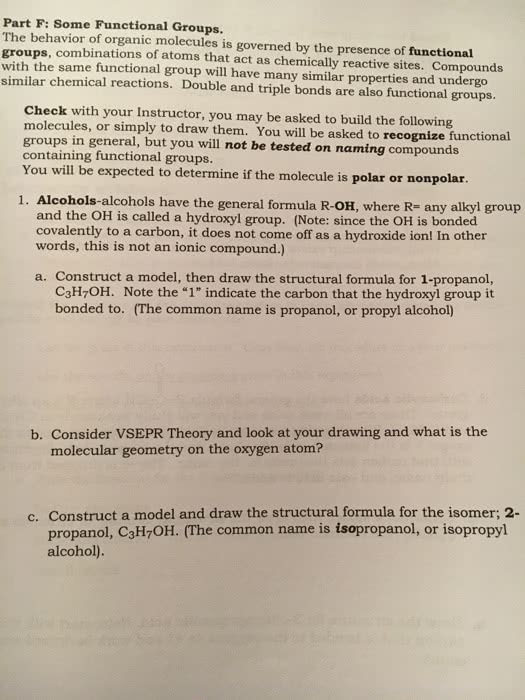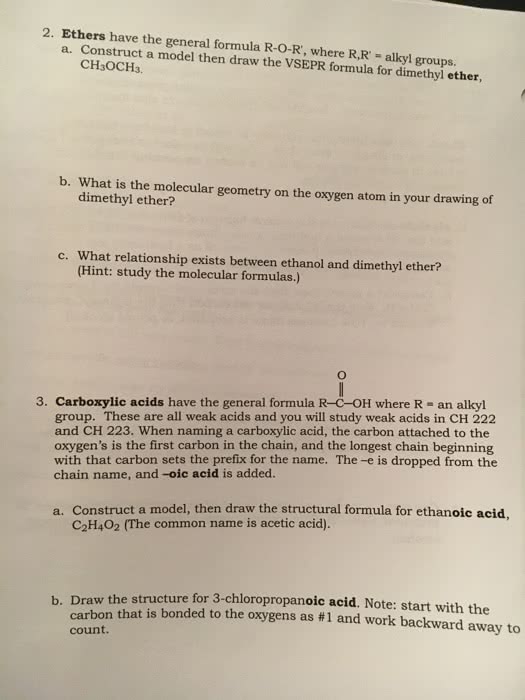CHEM 127 Lecture Notes - Lecture 1: Epoxide, Molecular Geometry, Ring Strain

Chemistry Chapter 9
9.1
Alcohols, ethers, and epoxides are three functional groups that contain carbon-oxygen σ bonds
- Alcohols contain a hydroxyl group (OH group) bonded to an sp3 hybridized carbon atom.
- Alcohols are also classified as primary (1o), secondary (2o), or tertiary (3o) based on the
number of carbon atoms bonded to the carbon with the OH group.
- Compounds having a hydroxyl group on an sp2 hybridized carbon atom – enols and phenols –
undergo different reactions than alcohols.
- Enols have an OH group on a carbon of a C-C double bond.
- Phenols have an OH group on a benzene ring
- Ethers have two alkyl groups bonded to an oxygen atom.
- An ether is symmetrical if the two alkyl groups are the same, and unsymmetrical if
they are different
- Both alcohols and ethers are organic derivatives of H2O, formed by replacing one or both of the
hydrogens on the oxygen atom by R groups
- Epoxides are ethers having the oxygen atom in a three-membered ring.
- Epoxides are also called oxiranes
9.2
Alcohols, ethers, and epoxides each contain an oxygen atom surrounded by two atoms and two
nonbounded electron pairs, making the O atom tetrahedral and sp3 hybridized.
- Because only two of the four groups around O are atoms, alcohols and ethers have a bent shape
like H2O
- The bond angle around the O atom in an alcohol or ether is similar to the tetrahedral
bond angle of 109.5o.
-In contrast, the C-O-C bond angle of an epoxide must be 60o, a considerable
deviation from the tetrahedral bond angle.
- For this reason, epoxides have angle strain, making them much more reactive
than other ethers
- Because oxygen is much more electronegative than carbon or hydrogen, the C-O and O-H
bonds are all polar, with the O atom electron rich and the C and H atoms electron poor.
9.3
Naming Alcohols
- In the IUPAC system, alcohols are identified by the suffix –ol
1) Find the longest carbon chain containing the carbon bonded to the OH group
2) Number the carbon chain to the give the OH group the lower number, and apply all
other rules of nomenclature
- When an OH group is bonded to a ring, the ring is numbered beginning with the OH group.
Because the functional group is always at C1, the “1” is usually omitted from the name. The ring
is then numbered in a clockwise or counterclockwise fashion to give the next substituent the
lower number
- Common names are often used for simple alcohols. To assign a common name:
- Name all the carbon atoms of the molecule as a single alkyl group
- Add the word alcohol, separating the words with a space
find more resources at oneclass.com
find more resources at oneclass.com
Document Summary
Alcohols, ethers, and epoxides are three functional groups that contain carbon-oxygen bonds. Alcohols are also classified as primary (1o), secondary (2o), or tertiary (3o) based on the number of carbon atoms bonded to the carbon with the oh group. Enols have an oh group on a carbon of a c-c double bond. Phenols have an oh group on a benzene ring. An ether is symmetrical if the two alkyl groups are the same, and unsymmetrical if they are different. Alcohols contain a hydroxyl group (oh group) bonded to an sp3 hybridized carbon atom. Compounds having a hydroxyl group on an sp2 hybridized carbon atom enols and phenols undergo different reactions than alcohols. Ethers have two alkyl groups bonded to an oxygen atom. Both alcohols and ethers are organic derivatives of h2o, formed by replacing one or both of the hydrogens on the oxygen atom by r groups. Epoxides are ethers having the oxygen atom in a three-membered ring.






